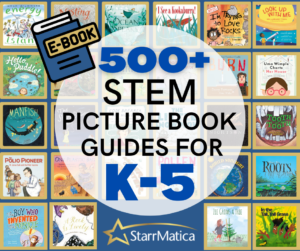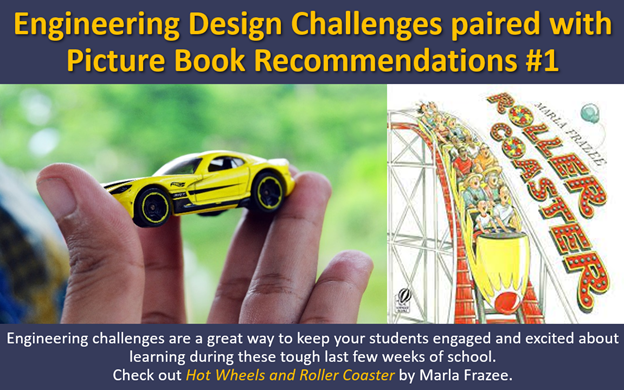If your students are anything like my fourth graders, by the time we get to May, we’re all getting a little antsy. The weather in the United States is getting warmer, we’ve been working hard all year, and we’re all ready to climb out the classroom window at any moment to run around the playground like pollinating bees. (Which you can do for a fun exercise break with your class!) That’s why all this month, I’m going to be sharing engineering design challenges. Engineering challenges are a great way to keep your students engaged and excited about learning during these sometimes tough last few weeks of school.
As a teacher, they provide a vehicle for you to meet all three dimensions of the NGSS. They are an authentic way for students to use science and engineering practices while examining the disciplinary core ideas through the lenses of cross-cutting concepts. (More about this later. I’ll include which performance expectations, practices, and concepts you’ll meet with each post!)
If you are teaching using the 5Es, these challenges fit well doing the Elaborate phase. Elaborate is an excellent opportunity to introduce an engineering challenge because engineering requires applying science knowledge to solve a problem. That’s exactly what the Elaborate phase is all about – encouraging students to transfer the knowledge they just acquired and apply it in new ways.
Since helping teachers use literature effectively during science instruction our specialty, I’ll be recommending a picture book connection with each challenge as well as sharing how and when that picture book should be used during instruction.
Important Note: These posts aren’t intended to provide an entire NGSS-aligned lesson plan. My goal is to focus on sharing a high-quality picture book, engineering challenge, and question recommendations that you can use as a springboard to create a lesson that meets your specific classroom needs.
Without further ado, our first challenge is: The Hot Wheels Challenge paired with Roller Coaster by Marla Frazee
Typically, literature should be introduced after students have had the opportunity to design and test their solutions because many picture books “give away” the information the students should be learning themselves. It isn’t much fun to design a bridge if you have already been taught the seven main types of bridges and what makes them structurally sound. You’re going to end up with a lot of bridges that look alike and mimic what they saw in the picture book.
However, I’m going to break my own rules with this first challenge and recommend that you read the picture book first. In Roller Coaster, Marla Frazee recreates the experience of riding a roller coaster through her text and illustrations. It builds background knowledge for kids who haven’t experienced a roller coaster ride before. (Which may be most of your students if they can’t yet meet the height requirements!) The book should cause your students to begin thinking about forces and wondering, “How does a roller coaster work?”
Questions to Ask While Reading: When the train is being pulled up the hill, ask your students: What do you notice? What do you wonder? And then again, on the page where the train goes all the way around the loop, ask the same questions.
Ask your students to compare the page where the train is being pulled up the hill with the page where the train zips or the train zooms. How and why are these pages different in their text and illustrations? How did Marla Frazee try to make you feel like you were on a roller coaster? How are the actions shown on these pages different?
The Challenge: Group your students and give them each a few sections of Hot Wheels Track and a car.
That’s it. (Resist the temptation to give them blocks or books to prop up one end to create a ramp!) Tell them that they can find or ask for other materials in the classroom if they need them later for their designs. (Note: You can buy 40 ft. of track at Amazon for $20)
Below are example design requirements you could give students. Challenge them to design a solution using the materials you gave them and any other materials they can find. (Again, resist the temptation to tell them to raise and lower the track or to provide them with something to stop the car at the end. Let them figure out their designs!)
- Design a track that will make the car travel the shortest distance possible after rolling off the track.
- Design a track to make the car travel the farthest distance possible after rolling off the track.
- Design a track that will slow the car down, so it rolls to a stop at a specific location.
- Design a track that will cause the car to stop at the end of the track and not roll across the floor.
- Design a track that will allow the car to roll over a hill.
- Design a track that will change the car’s direction at the end of the track so it will roll into a cup.
- Design a track that requires a pull to get the car started (like the roller coaster).
- Design a track that requires a soft push to get the car started and one that requires a hard push.
You can have your students draw their track ideas before building them and/or after creating them. Have groups share and discuss their different designs. What did you try first? How did you modify your design so it would work better? Which designs met the criteria? Which designs didn’t meet the criteria? Why? Which solutions were the best? Why?
The structure of the lesson is up to you and your students. The idea is to get your students experimenting with forces so they can develop the concept that a force causes a change in the speed or direction of an object. With younger students, you can describe the strength of pushes and pulls. With older students, you can bring in the concepts of gravity and friction.
If you are a StarrMatica Texts: Science Your Way subscriber, you can check out the forces and motion informational texts below. Remember, each 1st – 5th grade text has multiple reading levels so all of your students can read the same content independently. I recommend having students read these texts after they have conducted their track experiments. This way the students are using them as a resource to learn vocabulary and background information to help them explain what they have discovered on their own.
- 5th Grade: Gravity’s Forceful Nature
- 3rd Grade: May The Force Be With You
- Kindergarten: Push This Way! Pull That Way!
- Kindergarten: Push Hard! Push Soft!
- Kindergarten: Push and Pull
Not a subscriber? Click here for a free trial to access the texts above.
Next Generation Science Standards Connections:
Several performance expectations fit well with this challenge:
- K-PS1-1 Plan and conduct an investigation to compare the effects of different strengths or different directions of pushes and pulls on the motion of an object.
- K-PS2-2 Analyze data to determine if a design solution works as intended to change the speed or direction of an object with a push or a pull.
- 3-PS2-1 Plan and conduct an investigation to provide evidence of the effects of balanced and unbalanced forces on the motion of an object.
- 5-PS2-1 Support an argument that the gravitational force exerted by Earth on objects is directed down.
Cause and effect is the main cross-cutting concept that fits well with this challenge. Have students think about: What happened when you did XYZ to your track? What caused your car to do XYZ?
And students are using nearly all of the science and engineering practices. They are asking questions and defining problems as they test and redesign their tracks. They are developing and using models as they draw their designs. Students are planning and carrying out investigations and constructing explanations and designing solutions during their track building and testing. When they share their tracks with peers, they are obtaining, evaluating, and communicating information. In upper elementary, there are many possibilities for incorporating analyzing and interpreting data and using mathematics and computational thinking. For example, you could have your students measure the height of their ramps and how far their cars travel off the end.
Bottom line: Enjoy these last few weeks with your students. Ask questions, let them take the lead, and have fun!!
 Are you are looking for additional picture books for your science classroom, check out the Perfect Picture Book Pairing Series that includes one-page guides with activities and discussion questions for hundreds of STEM-themed picture books aligned to every NGSS performance expectation!
Are you are looking for additional picture books for your science classroom, check out the Perfect Picture Book Pairing Series that includes one-page guides with activities and discussion questions for hundreds of STEM-themed picture books aligned to every NGSS performance expectation!
CLICK HERE TO PREVIEW THE PERFECT PICTURE BOOK PAIRING EBOOKS

